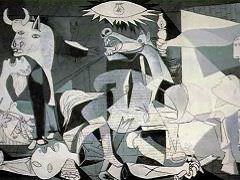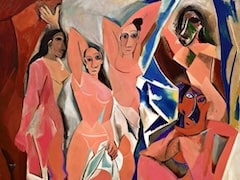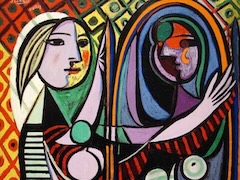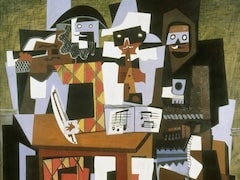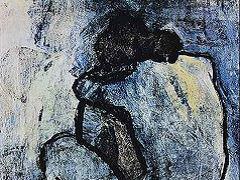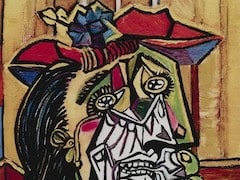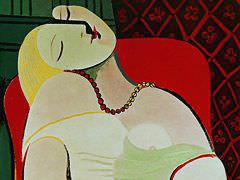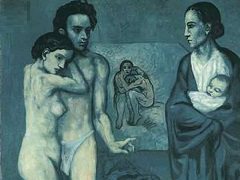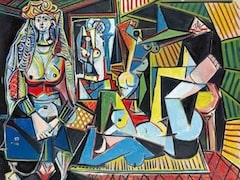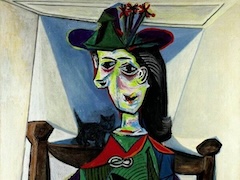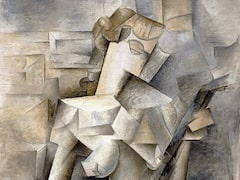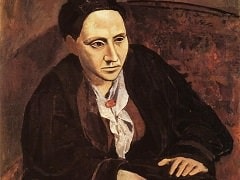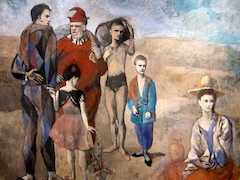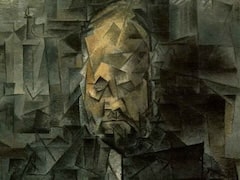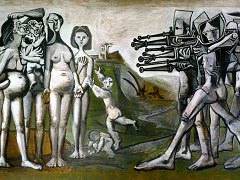Background of Les Demoiselles d'Avignon by Pablo Picasso
The Development
Picasso came into his own as an important artist during the first decade of the 20th century. He arrived in Paris from Spain around the turn of the century as a young, ambitious painter out to make a name for himself. Although he
eventually left most of his friends, relatives and contacts in Spain, he continued to live and paint in Spain while making regular trips back to France. For several years he alternated between living and working in Barcelona,
Madrid and the Spanish countryside, and made frequent trips to Paris. By 1904, he was fully settled in Paris and had established several studios, important relationships with both friends and colleagues. Between 1901 and 1904,
Picasso began to achieve recognition for his Blue period paintings. In the main these were studies of poverty and desperation based on scenes he had seen in Spain and Paris at the turn of the century. Subjects included gaunt
families, blind figures, and personal encounters; other paintings depicted his friends, but most reflected and expressed a sense of blueness and despair.
He followed his success by developing into his Rose period from 1904 to 1907, which introduced a strong element of sensuality and sexuality into his work. The Rose period depictions of acrobats,
circus performers and theatrical characters are rendered in warmer, brighter colors and are far more hopeful and joyful in their depictions of the bohemian life in the Parisian avant-garde and its environs. The Rose period
produced two important large masterpieces: Family of Saltimbanques (1905), which recalls the work of Edouard Manet; and
Boy Leading a Horse (1906), which recalls Cézanne's Bather and
El Greco's Saint Martin and the Beggar. While he already had a considerable following by the middle of 1906, Picasso enjoyed
further success with his paintings of massive over-sized nude women, monumental sculptural figures that recalled the work of Gauguin and showed his interest in primitive (African, Micronesian,
Native American) art. He began exhibiting his work in the galleries of Berthe Weill (1865-1951) and Ambroise Vollard (1866-1939), quickly gaining a growing reputation and a following amongst the artistic community of Montparnasse.
Rivalry with Henri Matisse
The Salon d'Automne of 1905 brought notoriety and attention to the works of Henri Matisse and the Les Fauves group. The latter gained their name after critic Louis Vauxcelles described
their work with the phrase "Donatello au milieu des fauves!" ("Donatello among the wild beasts"), contrasting the paintings with a Renaissance-type sculpture that shared the room with them. Henri Rousseau (1844-1910),
an artist that Picasso knew and admired and who was not a Fauve, had his large jungle scene The Hungry Lion Throws Itself on the Antelope
also hanging near the works by Matisse and which may have had an influence on the particular sarcastic term used in the press. Vauxcelles' comment was printed on 17 October 1905 in the daily newspaper Gil Blas, and passed
into popular usage.
Matisse's notoriety and preeminence as the leader of the new movement in modern painting continued to build throughout 1906 and 1907, and Matisse attracted a following of artists including Georges Braque,
André Derain (1880-1954), Maurice de Vlaminck (1876-1958). Picasso's work had passed through his Blue period and his Rose period and while he had a considerable
following his reputation was tame in comparison to his rival Matisse. To make matters worse Matisse shocked the French public again at the 1907 Société des Artistes Indépendants when he exhibited his painting
Blue Nude(Souvenir de Biskra), completed in early 1907. The Blue Nude was one of the paintings that would later create an international sensation at the Armory Show
of 1913 in New York City.

